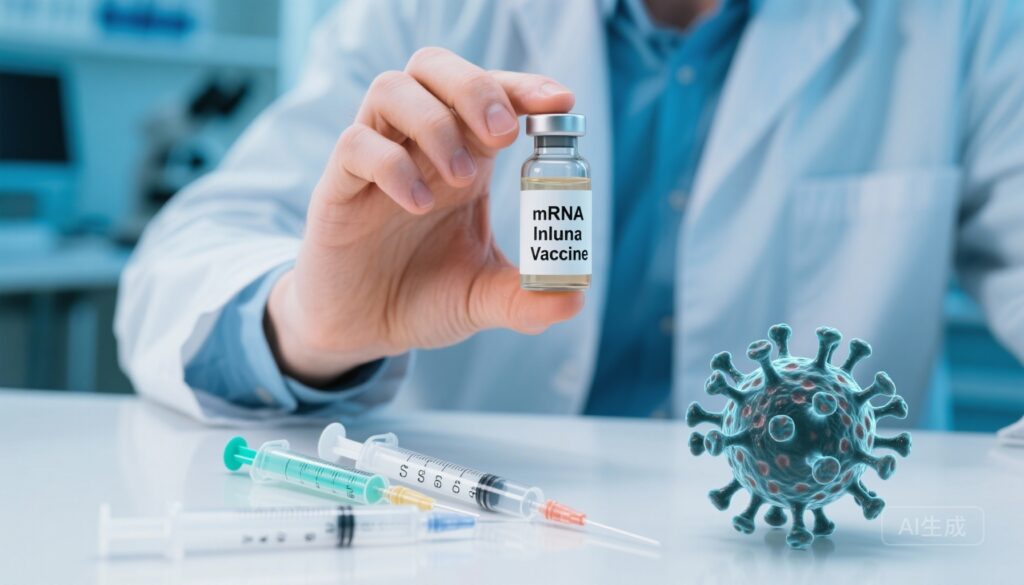Highlights
– Pfizer’s modified nucleoside mRNA quadrivalent influenza vaccine showed a statistically superior relative efficacy of 34.5% (95% CI 7.4–53.9) versus a licensed inactivated quadrivalent vaccine in adults 18–64 years during the 2022–2023 season.
– Efficacy and HAI noninferiority were demonstrated for influenza A/H3N2 and A/H1N1 strains but not for influenza B strains; most cases in the trial were A strains.
– Reactogenicity (local and systemic) and fever were more frequent after the mRNA vaccine, but serious adverse events were rare and similar between groups.
Background
Seasonal influenza causes substantial morbidity and mortality worldwide despite annual immunization programs. Conventional licensed influenza vaccines (egg- or cell-culture–derived inactivated vaccines and recombinant protein vaccines) reduce illness and severe outcomes but have variable effectiveness that depends on strain match and host factors such as age and prior immunity. mRNA vaccine technology—validated at scale during the SARS-CoV-2 pandemic—offers theoretical advantages for influenza vaccination: rapid antigen updating, precise antigen expression, scalable manufacturing, and the ability to encode multiple antigens. Early-phase clinical data for modified nucleoside mRNA (modRNA) influenza vaccines showed promising immunogenicity and acceptable safety, prompting pivotal phase 3 evaluation.
Study design
This randomized, active-controlled, phase 3 trial (Pfizer C4781004; NCT05540522) enrolled 18,476 healthy adults aged 18–64 years across sites in the United States, South Africa, and the Philippines during the 2022–2023 influenza season. Participants were randomized roughly 1:1 to receive a single dose of the quadrivalent modRNA influenza vaccine (modRNA group; n=9,225) or a licensed inactivated quadrivalent influenza vaccine (control group; Fluzone; n=9,251).
The primary efficacy endpoint was relative vaccine efficacy, defined as the reduction in the percentage of participants with laboratory-confirmed influenza associated with influenza-like illness (ILI) occurring at least 14 days after vaccination in the modRNA group compared with the control group. The statistical analysis evaluated both noninferiority and superiority. Immunogenicity was assessed using hemagglutination inhibition (HAI) assays. Safety evaluations included solicited local and systemic reactogenicity for 7 days, adverse events through 1 month, and serious adverse events through 6 months.
Key findings
Primary efficacy
During the surveillance period, there were 57 cases of laboratory-confirmed influenza associated with ILI in the modRNA group and 87 cases in the control group. The resulting relative efficacy of the modRNA vaccine versus the licensed inactivated vaccine was 34.5% (95% confidence interval [CI], 7.4 to 53.9). This result met pre-specified criteria for both noninferiority and superiority.

Virology and strain-specific observations
Nearly all documented influenza cases in the trial were caused by influenza A viruses (both A/H3N2 and A/H1N1). There were almost no influenza B cases in the study period, limiting power to assess B-lineage efficacy. Immunogenicity analyses using HAI assays demonstrated noninferiority of antibody responses for the influenza A strains but did not meet noninferiority criteria for influenza B strains.
Immunogenicity
HAI responses were higher against A/H3N2 and A/H1N1 in the modRNA group compared with the control group, consistent with the observed efficacy advantage against circulating A-lineage viruses. The trial did not demonstrate HAI noninferiority for the B strains, mirroring prior challenges reported in mRNA influenza vaccine development whereby formulation or antigen selection required optimization to achieve robust B-lineage responses.
Reactogenicity and adverse events
Solicited local and systemic reactions were more frequent in the modRNA group than in the control group. Local reactions (e.g., pain at the injection site) occurred in 70.1% of participants receiving the modRNA vaccine versus 43.1% of controls. Overall systemic events (e.g., fatigue, headache, myalgia) were reported in 65.8% of the modRNA group versus 48.7% of controls. Fever was reported in 5.6% of participants in the modRNA group compared with 1.7% in the control group.
Serious adverse events (SAEs) were uncommon and occurred at similar rates across groups. The trial reported one participant with a grade 3 injection-site reaction and one participant with a grade 4 allergic reaction that investigators judged vaccine-related. Importantly, no cases of myocarditis or pericarditis were observed in this trial population, although the sample size and follow-up duration limit conclusions about very rare events.
Subgroup and population considerations
The trial enrolled only adults 18–64 years, so extrapolation to older adults (≥65 years), children, pregnant persons, and immunocompromised patients cannot be made from this dataset. The geographic spread (United States, South Africa, Philippines) supports some diversity of exposure and circulation patterns, but the low prevalence of influenza B during the study season constrained the vaccine’s evaluated performance against B-lineage viruses.
Expert commentary and interpretation
The key clinical takeaway is that a quadrivalent modified mRNA influenza vaccine can outperform a licensed inactivated comparator against circulating influenza A strains in working-age adults. A between-group relative efficacy of 34.5% is clinically meaningful in a season dominated by A-lineage viruses and could translate into fewer symptomatic cases, fewer medical visits, and reduced transmission, particularly in years when A/H3N2 drives severe disease.
Biological plausibility of improved protection stems from the mRNA platform’s ability to present antigen in a native-like conformation, induce strong humoral and cellular responses, and be rapidly reformulated should antigenic drift occur. However, the failure to establish HAI noninferiority for influenza B underscores that antigen selection, dose, formulation (e.g., lipid nanoparticle composition), and possibly expression dynamics differ across viral lineages and require optimization.
From a safety perspective, the higher reactogenicity profile seen with the modRNA vaccine is consistent with prior experience from mRNA COVID-19 vaccines and prior mRNA influenza candidate studies. The increased frequency of transient local and systemic reactions — and a small absolute increase in fever — must be weighed against efficacy benefits. Rare but serious adverse events (including myocarditis) were not observed here, but larger post-licensure surveillance will be necessary to detect very rare safety signals.
Limitations and unresolved questions
– Seasonality and strain distribution: Because trial cases were predominantly influenza A, the study provides limited evidence about performance against B-lineage viruses. Future trials or post-marketing data in seasons with B-lineage circulation are needed.
– Age groups: Older adults (≥65 years), who bear disproportionate influenza morbidity and mortality, were not included and may respond differently to modRNA formulations; dedicated trials in that age group are required.
– Durability and breadth: The trial measured efficacy in a single season; data on durability of protection beyond several months and cross-protection against antigenically drifted strains remain to be characterized.
– Safety surveillance: Although SAEs were rare and similar between arms, detection of very rare events requires larger populations and longer follow-up in real-world use.
– Operational and policy considerations: Supply, cost, cold-chain needs, frequency of booster updating, and vaccine acceptance given higher reactogenicity will influence uptake and public health impact.
Clinical and public health implications
If regulatory authorities accept these data, an approved mRNA influenza vaccine would expand the armamentarium for annual influenza prevention. The demonstrated benefit against A-strains is particularly relevant in A-predominant seasons and could reduce symptomatic infections and downstream complications. Policymakers and clinicians should anticipate that initial approvals may be limited to specific age groups based on available data and that labeling may include statements about reactogenicity and the evidence gap for influenza B and older adults.
From an industry and vaccine-development perspective, the result validates further investment in mRNA influenza programs and supports accelerated regulatory engagement. The mRNA platform’s speed for antigen update could improve strain matching in years with late antigenic shifts, but logistical, manufacturing, and distribution systems will need adaptation for seasonal deployment at scale.
Conclusion
The phase 3 C4781004 trial provides evidence that Pfizer’s quadrivalent modified mRNA influenza vaccine confers superior protection compared with a licensed inactivated quadrivalent vaccine against laboratory-confirmed influenza associated with ILI during the 2022–2023 season in adults aged 18–64. The benefit was driven by influenza A strain protection and accompanied by increased local and systemic reactogenicity. Key next steps include evaluation in older adults and other special populations, head-to-head or seasonal comparisons over multiple seasons to assess robustness against B strains and drifted viruses, and comprehensive post-licensure safety monitoring.
Funding and trial registration
The trial was funded by Pfizer. ClinicalTrials.gov identifier: NCT05540522. Full trial report: Fitz-Patrick D, McVinnie DS, Jackson LA, et al. Efficacy, Immunogenicity, and Safety of Modified mRNA Influenza Vaccine. N Engl J Med. 2025 Nov 20;393(20):2001-2011. doi: 10.1056/NEJMoa2416779 IF: 78.5 Q1 . PMID: 41259756 IF: 78.5 Q1 .
Selected references
1. Fitz-Patrick D, McVinnie DS, Jackson LA, et al. Efficacy, Immunogenicity, and Safety of Modified mRNA Influenza Vaccine. N Engl J Med. 2025 Nov 20;393(20):2001-2011. doi:10.1056/NEJMoa2416779 IF: 78.5 Q1 . PMID: 41259756 IF: 78.5 Q1 .
2. Pfizer press release and public disclosures on phase 3 data (company materials) and relevant industry reporting. See also coverage summarizing phase 3 results: Fierce Biotech, November 2025. https://www.fiercebiotech.com/biotech/pfizer-details-phase-3-data-mrna-flu-vaccine



